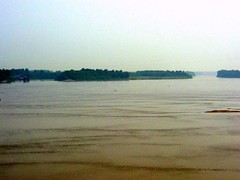Pittsburgh cabbie has a stake in saving La.'s coast / John Barry
May 12 Washington Post.
John M. Barry is the author of the book Rising Tide, an award-winning
examination of the Miss. flood of 1927.
There has been much debate in the past 20 months over protecting Louisiana from another lethal hurricane, but nearly all of it has been conducted without any real understanding of the geological context. Congress and the Bush administration need to recognize six facts that define the national interest.
Fact 1: The Gulf of Mexico once reached north to Cape Girardeau, Mo. But the Mississippi River carries such an enormous sediment load that, combined with a falling sea level, it deposited enough sediment to create 35,000 square miles of land from Cape Girardeau to the present mouth of the river.
This river-created land includes the entire coast, complete with barrier islands, stretching from Mississippi to Texas. But four human interventions have interfered with this natural process; three of them that benefit the rest of the country have dramatically increased the hurricane threat to the Gulf Coast.
Fact 2: Acres of riverbank at a time used to collapse into the river system providing a main source of sediment. To prevent this and to protect lives and property, engineers stopped such collapses by paving hundreds of miles of the river with riprap and even concrete, beginning more than 1,000 miles upriver — including on the Ohio, Missouri and other tributaries — from New Orleans. Reservoirs for flood protection also impound sediment. These and other actions deprive the Mississippi of 60 to 70 percent of its natural sediment load, starving the coast.
Fact 3: To stop sandbars from blocking shipping at the mouth of the Mississippi, engineers built jetties extending more than two miles out into the Gulf of Mexico. This engineering makes Tulsa, Kansas City, Minneapolis, Cincinnati, Pittsburgh and other cities into ports with direct access to the ocean, greatly enhancing the nation's economy. The river carries 20 percent of the nation's exports, including 60 percent of its grain exports, and the river at New Orleans is the busiest port in the world. But the jetties prevent any of the sediment remaining in the river from replenishing the Louisiana and Mississippi coasts and barrier islands; instead, the jetties drop the sediment off the continental shelf.
Fact 4: Levees that prevent river flooding in Louisiana and Mississippi interfere with the replenishment of the land locally as well.
Fact 5: Roughly 30 percent of the country's domestic oil and gas production comes from offshore Louisiana, and to service that production the industry created more than 10,000 miles of canals and pipelines through the marsh.
Every inch of those 10,000-plus miles lets saltwater penetrate, and eat away at, the coast. So energy production has enormously accelerated what was a slow degradation, transforming a long-term problem into an immediate crisis. The deprivation of sediment is like moving a block of ice from the freezer to the sink, where it begins to melt; the effect of the canals and pipelines is like attacking that ice with an ice pick, breaking it up.
As a result, 2,100 square miles of coastal land and barrier islands have melted into the Gulf of Mexico. This land once served as a buffer between the ocean and populated areas in Louisiana and part of Mississippi, protecting them during hurricanes. Each land mile over which a hurricane travels absorbs roughly a foot of storm surge.
The nation as a whole gets nearly all the benefits of engineering the river. Louisiana and some of coastal Mississippi get 100 percent of the costs. Eastern New Orleans (including the lower 9th Ward) and St. Bernard Parish — nearly all of which, incidentally, is at or above sea level — exemplify this allocation of costs and benefits. Three man-made shipping canals pass through them, creating almost no jobs there but benefiting commerce throughout the country. Yet nearly all the 175,000 people living there saw their homes flooded not because of any natural vulnerability but because of levee breaks. These levee breaks were along these three man-made shipping canals.
Fact 6: Without action, land loss will continue, and it will increasingly jeopardize populated areas, the port system and energy production. This would be catastrophic for America. Scientists say the problem can be solved, even with rising sea levels, but that we have only a decade to begin addressing it in a serious way or the damage may be irreversible.
Despite all this and President Bush's pledge from New Orleans in September 2005 that "we will do what it takes" to help people rebuild, a draft White House cuts its own recommendation of $2 billion for coastal restoration to $1 billion while calling for an increase in the state's contribution from the usual 35 percent to 50 percent. This turns the idea of the Union on its head. Generating benefits to the nation is what created the problem, and the nation needs to solve it. Put simply: Why should a cab driver in Pittsburgh or Tulsa pay to fix Louisiana's coast? Because he gets a stronger economy and lower energy costs from it, and because his benefits created the problem.
The failure of Congress and the president to act aggressively to repair the coastline at the mouth of the Mississippi River could threaten the economic vitality of the nation. Louisiana, one of the poorest states, can no longer afford to underwrite benefits for the rest of the nation.
Subscribe to:
Post Comments (Atom)


No comments:
Post a Comment